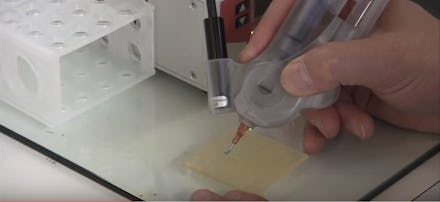The BioPen 3-D Prints Stem Cells That Can Fix Your Creaky Joints — and That's Cool as Hell

We can 3-D print a lot of strange and wonderful things: disposable robots, vertebrae, prosthetics, the entire internet — in space. Soon, science may just add another mind-blowing item to that list. There now exists a prototypical pen that 3-D prints stem cells. Called the BioPen, it would allow surgeons to "draw new cartilage" inside a patient's joints, Mashable's Lance Ulanoff reported.
Read more: It's Finally Possible to 3-D Print Human Tissue — Here's How It Could Change Medicine
BioPen is the creation of Peter Choong — director of orthopedics at Melbourne's St. Vincent's Hospital — and Gordon Wallace, the director of Australian Research Council's Center of Excellence for Electromaterials Science. In March, ACES published a paper on the BioPen's development and function, but the device was actually Choong's brainchild, Mashable reported. It's an ingenious and cost-effective device, but "the magic is in the ink — this time the bio ink," Wallace told Mashable.
This bio-ink incorporates adipose stem cells from human fat cells into a "polymer-based hydrogel" that the pen extrudes into the damaged cartilage and hardens with a UV light, according to Mashable. It's "in-situ biofabrication," according to the paper; "the surgeon sculpts the material as he or she draws," in Ulanoff's words. The stem cells allegedly have a "very high" 97 percent survival rate.
There are a few drawbacks, which researchers are working to correct with the addition of temperature control technology — the flow of gel from BioPen's titanium tip can vary with air temperature and that of the heat hand holding the pen. The pressure mechanism that pushes gel out of the pen can also mean spotty distribution.
Once developers work out the kinks, we'll be that much closer to being able to redraw human joints. One wonders what other stem cell-improved ailments might also benefit from this 3-D printing breakthrough.
h/t Mashable